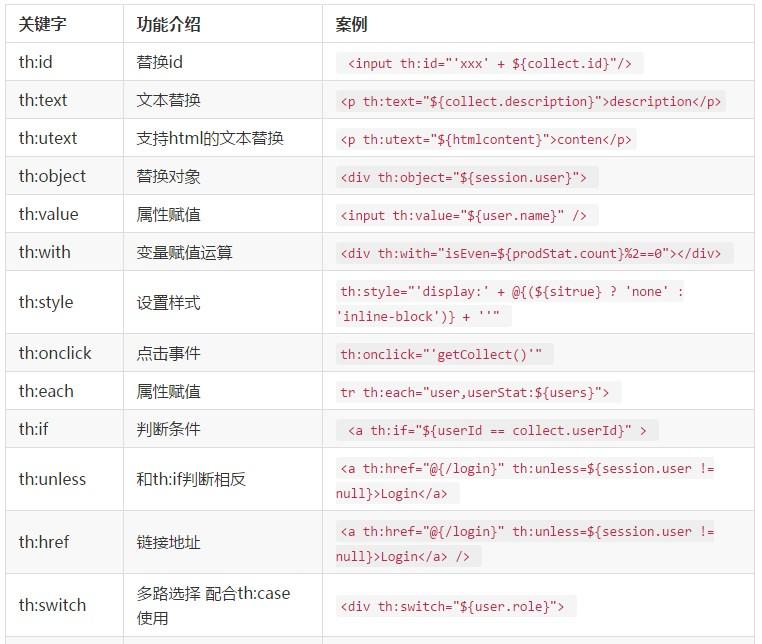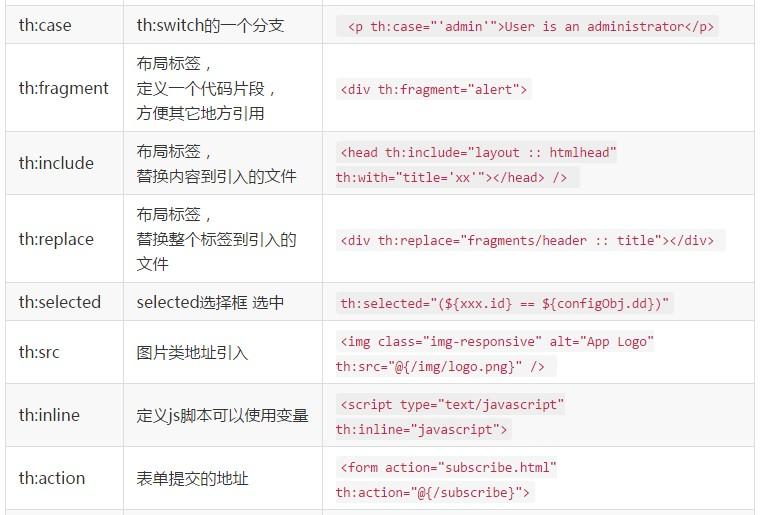Spring Boot系列(四):thymeleaf使用详解
在上篇文章Spring Boot系列(二):web综合开发中简单介绍了一下thymeleaf,这篇文章将更加全面详细的介绍thymeleaf的使用。thymeleaf 是新一代的模板引擎,在spring4.0中推荐使用thymeleaf来做前端模版引擎。
thymeleaf介绍
简单说, Thymeleaf 是一个跟 Velocity、FreeMarker 类似的模板引擎,它可以完全替代 JSP 。相较与其他的模板引擎,它有如下三个极吸引人的特点:
-
1.Thymeleaf 在有网络和无网络的环境下皆可运行,即它可以让美工在浏览器查看页面的静态效果,也可以让程序员在服务器查看带数据的动态页面效果。这是由于它支持 html 原型,然后在 html 标签里增加额外的属性来达到模板+数据的展示方式。浏览器解释 html 时会忽略未定义的标签属性,所以 thymeleaf 的模板可以静态地运行;当有数据返回到页面时,Thymeleaf 标签会动态地替换掉静态内容,使页面动态显示。
-
2.Thymeleaf 开箱即用的特性。它提供标准和spring标准两种方言,可以直接套用模板实现JSTL、 OGNL表达式效果,避免每天套模板、该jstl、改标签的困扰。同时开发人员也可以扩展和创建自定义的方言。
-
3.Thymeleaf 提供spring标准方言和一个与 SpringMVC 完美集成的可选模块,可以快速的实现表单绑定、属性编辑器、国际化等功能。
标准表达式语法
它们分为四类:
- 1.变量表达式
- 2.选择或星号表达式
- 3.文字国际化表达式
- 4.URL表达式
变量表达式
变量表达式即OGNL表达式或Spring EL表达式(在Spring术语中也叫model attributes)。如下所示:${session.user.name}
它们将以HTML标签的一个属性来表示:
<span th:text="${book.author.name}">
<li th:each="book : ${books}">
选择(星号)表达式
选择表达式很像变量表达式,不过它们用一个预先选择的对象来代替上下文变量容器(map)来执行,如下:*{customer.name}
被指定的object由th:object属性定义:
<div th:object="${book}">
...
<span th:text="*{title}">...</span>
...
</div>
文字国际化表达式
文字国际化表达式允许我们从一个外部文件获取区域文字信息(.properties),用Key索引Value,还可以提供一组参数(可选).
#{main.title}
#{message.entrycreated(${entryId})}
可以在模板文件中找到这样的表达式代码:
<table>
...
<th th:text="#{header.address.city}">...</th>
<th th:text="#{header.address.country}">...</th>
...
</table>
URL表达式
URL表达式指的是把一个有用的上下文或回话信息添加到URL,这个过程经常被叫做URL重写。
@{/order/list}
URL还可以设置参数: @{/order/details(id=${orderId})}
相对路径: @{../documents/report}
让我们看这些表达式:
<form th:action="@{/createOrder}">
<a href="main.html" th:href="@{/main}">
变量表达式和星号表达有什么区别吗?
如果不考虑上下文的情况下,两者没有区别;星号语法评估在选定对象上表达,而不是整个上下文
什么是选定对象?就是父标签的值,如下:
<div th:object="${session.user}">
<p>Name: <span th:text="*{firstName}">Sebastian</span>.</p>
<p>Surname: <span th:text="*{lastName}">Pepper</span>.</p>
<p>Nationality: <span th:text="*{nationality}">Saturn</span>.</p>
</div>
这是完全等价于:
<div th:object="${session.user}">
<p>Name: <span th:text="${session.user.firstName}">Sebastian</span>.</p>
<p>Surname: <span th:text="${session.user.lastName}">Pepper</span>.</p>
<p>Nationality: <span th:text="${session.user.nationality}">Saturn</span>.</p>
</div>
当然,美元符号和星号语法可以混合使用:
<div th:object="${session.user}">
<p>Name: <span th:text="*{firstName}">Sebastian</span>.</p>
<p>Surname: <span th:text="${session.user.lastName}">Pepper</span>.</p>
<p>Nationality: <span th:text="*{nationality}">Saturn</span>.</p>
</div>
表达式支持的语法
字面(Literals)
- 文本文字(Text literals):
'one text', 'Another one!',… - 数字文本(Number literals):
0, 34, 3.0, 12.3,… - 布尔文本(Boolean literals):
true, false - 空(Null literal):
null - 文字标记(Literal tokens):
one, sometext, main,…
文本操作(Text operations)
- 字符串连接(String concatenation):
+ - 文本替换(Literal substitutions):
|The name is ${name}|
算术运算(Arithmetic operations)
- 二元运算符(Binary operators):
+, -, *, /, % - 减号(单目运算符)Minus sign (unary operator):
-
#######布尔操作(Boolean operations)
- 二元运算符(Binary operators):
and, or - 布尔否定(一元运算符)Boolean negation (unary operator):
!, not
比较和等价(Comparisons and equality)
比较(Comparators): >, <, >=, <= (gt, lt, ge, le)
等值运算符(Equality operators):==, != (eq, ne)
条件运算符(Conditional operators)
If-then: (if) ? (then)
If-then-else: (if) ? (then) : (else)
Default: (value) ?: (defaultvalue)
所有这些特征可以被组合并嵌套:
'User is of type ' + (${user.isAdmin()} ? 'Administrator' : (${user.type} ?: 'Unknown'))
常用th标签都有那些?



还有非常多的标签,这里只列出最常用的几个,由于一个标签内可以包含多个th:x属性,其生效的优先级顺序为: include,each,if/unless/switch/case,with,attr/attrprepend/attrappend,value/href,src ,etc,text/utext,fragment,remove。
几种常用的使用方法
1、赋值、字符串拼接
<p th:text="${collect.description}">description</p>
<span th:text="'Welcome to our application, ' + ${user.name} + '!'">
字符串拼接还有另外一种简洁的写法
<span th:text="|Welcome to our application, ${user.name}!|">
2、条件判断 If/Unless
Thymeleaf中使用th:if和th:unless属性进行条件判断,下面的例子中,<a>标签只有在th:if中条件成立时才显示:
<a th:if="${myself=='yes'}" > </i> </a>
<a th:unless=${session.user != null} th:href="@{/login}" >Login</a>
th:unless于th:if恰好相反,只有表达式中的条件不成立,才会显示其内容。
也可以使用(if) ? (then) : (else)这种语法来判断显示的内容
3、for 循环
<tr th:each="collect,iterStat : ${collects}">
<th scope="row" th:text="${collect.id}">1</th>
<td >

</td>
<td th:text="${collect.url}">Mark</td>
<td th:text="${collect.title}">Otto</td>
<td th:text="${collect.description}">@mdo</td>
<td th:text="${terStat.index}">index</td>
</tr>
iterStat称作状态变量,属性有:
- index:当前迭代对象的index(从0开始计算)
- count: 当前迭代对象的index(从1开始计算)
- size:被迭代对象的大小
- current:当前迭代变量
- even/odd:布尔值,当前循环是否是偶数/奇数(从0开始计算)
- first:布尔值,当前循环是否是第一个
- last:布尔值,当前循环是否是最后一个
4、URL
URL在Web应用模板中占据着十分重要的地位,需要特别注意的是Thymeleaf对于URL的处理是通过语法@{…}来处理的。 如果需要Thymeleaf对URL进行渲染,那么务必使用th:href,th:src等属性,下面是一个例子
<!-- Will produce 'http://localhost:8080/standard/unread' (plus rewriting) -->
<a th:href="@{/standard/{type}(type=${type})}">view</a>
<!-- Will produce '/gtvg/order/3/details' (plus rewriting) -->
<a href="details.html" th:href="@{/order/{orderId}/details(orderId=${o.id})}">view</a>
设置背景
<div th:style="'background:url(' + @{/<path-to-image>} + ');'"></div>
根据属性值改变背景
<div class="media-object resource-card-image" th:style="'background:url(' + @{(${collect.webLogo}=='' ? 'img/favicon.png' : ${collect.webLogo})} + ')'" ></div>
几点说明:
- 上例中URL最后的
(orderId=${o.id})表示将括号内的内容作为URL参数处理,该语法避免使用字符串拼接,大大提高了可读性 -
@{...}表达式中可以通过{orderId}访问Context中的orderId变量 -
@{/order}是Context相关的相对路径,在渲染时会自动添加上当前Web应用的Context名字,假设context名字为app,那么结果应该是/app/order
5、内联js
内联文本:[[…]]内联文本的表示方式,使用时,必须先用th:inline=”text/javascript/none”激活,th:inline可以在父级标签内使用,甚至作为body的标签。内联文本尽管比th:text的代码少,不利于原型显示。
<script th:inline="javascript">
/*<![CDATA[*/
...
var username = /*[[${sesion.user.name}]]*/ 'Sebastian';
var size = /*[[${size}]]*/ 0;
...
/*]]>*/
</script>
js附加代码:
/*[+
var msg = 'This is a working application';
+]*/
js移除代码:
/*[- */
var msg = 'This is a non-working template';
/* -]*/
6、内嵌变量
为了模板更加易用,Thymeleaf还提供了一系列Utility对象(内置于Context中),可以通过#直接访问:
- dates : java.util.Date的功能方法类。
- calendars : 类似#dates,面向java.util.Calendar
- numbers : 格式化数字的功能方法类
- strings : 字符串对象的功能类,contains,startWiths,prepending/appending等等。
- objects: 对objects的功能类操作。
- bools: 对布尔值求值的功能方法。
- arrays:对数组的功能类方法。
- lists: 对lists功能类方法
- sets
- maps
…
下面用一段代码来举例一些常用的方法:
dates
/*
* Format date with the specified pattern
* Also works with arrays, lists or sets
*/
${#dates.format(date, 'dd/MMM/yyyy HH:mm')}
${#dates.arrayFormat(datesArray, 'dd/MMM/yyyy HH:mm')}
${#dates.listFormat(datesList, 'dd/MMM/yyyy HH:mm')}
${#dates.setFormat(datesSet, 'dd/MMM/yyyy HH:mm')}
/*
* Create a date (java.util.Date) object for the current date and time
*/
${#dates.createNow()}
/*
* Create a date (java.util.Date) object for the current date (time set to 00:00)
*/
${#dates.createToday()}
strings
/*
* Check whether a String is empty (or null). Performs a trim() operation before check
* Also works with arrays, lists or sets
*/
${#strings.isEmpty(name)}
${#strings.arrayIsEmpty(nameArr)}
${#strings.listIsEmpty(nameList)}
${#strings.setIsEmpty(nameSet)}
/*
* Check whether a String starts or ends with a fragment
* Also works with arrays, lists or sets
*/
${#strings.startsWith(name,'Don')} // also array*, list* and set*
${#strings.endsWith(name,endingFragment)} // also array*, list* and set*
/*
* Compute length
* Also works with arrays, lists or sets
*/
${#strings.length(str)}
/*
* Null-safe comparison and concatenation
*/
${#strings.equals(str)}
${#strings.equalsIgnoreCase(str)}
${#strings.concat(str)}
${#strings.concatReplaceNulls(str)}
/*
* Random
*/
${#strings.randomAlphanumeric(count)}
使用thymeleaf布局
使用thymeleaf布局非常的方便
定义代码片段
<footer th:fragment="copy">
© 2016
</footer>
在页面任何地方引入:
<body>
<div th:include="footer :: copy"></div>
<div th:replace="footer :: copy"></div>
</body>
th:include 和 th:replace区别,include只是加载,replace是替换
返回的HTML如下:
<body>
<div> © 2016 </div>
<footer>© 2016 </footer>
</body>
下面是一个常用的后台页面布局,将整个页面分为头部,尾部、菜单栏、隐藏栏,点击菜单只改变content区域的页面 ``` html
Header
left
sidebar
footer
任何页面想使用这样的布局值只需要替换中见的 content模块即可
``` html
<html xmlns:th="http://www.thymeleaf.org" layout:decorator="layout">
<body>
<section layout:fragment="content">
...
也可以在引用模版的时候传参
<head th:include="layout :: htmlhead" th:with="title='Hello'"></head>
layout 是文件地址,如果有文件夹可以这样写 fileName/layout:htmlheadhtmlhead 是指定义的代码片段 如 th:fragment="copy"
源码案例
这里有一个开源项目几乎使用了这里介绍的所有标签和布局,大家可以参考: cloudfavorites
参考
往期回顾
作者:纯洁的微笑
出处:www.ityouknow.com
版权所有,欢迎保留原文链接进行转载:)
在学习过程如果有任何疑问,请来极乐网提问,或者扫描下方二维码,关注极乐官方微信,在平台下方留言。
 极乐科技二维码
极乐科技二维码


